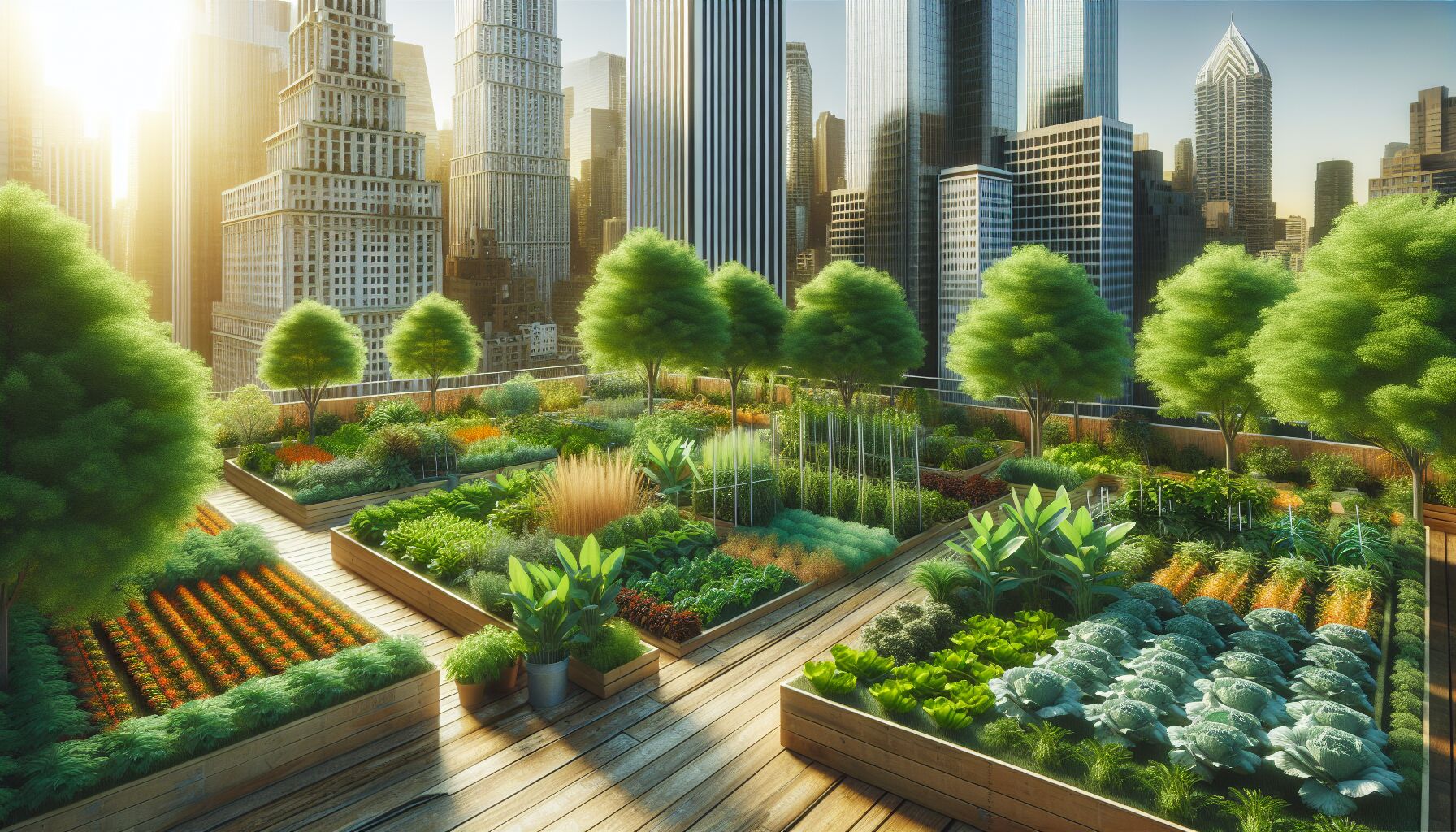 Urban agriculture is more than just planting seeds in the heart of the city — it’s kind of like pulling fresh produce straight from the earth in the concrete jungle. Why does it matter so much? Well, first off, growing food locally helps cut down on those elusive “food miles.” You know, the distance food travels from where it’s grown to your plate. Think about it: when your vegetables don’t have to trek across the country, they’re not only fresher but also pack more flavor and nutrients. It’s as if Mother Nature herself whispers, “this is how food should taste.”
Urban agriculture is more than just planting seeds in the heart of the city — it’s kind of like pulling fresh produce straight from the earth in the concrete jungle. Why does it matter so much? Well, first off, growing food locally helps cut down on those elusive “food miles.” You know, the distance food travels from where it’s grown to your plate. Think about it: when your vegetables don’t have to trek across the country, they’re not only fresher but also pack more flavor and nutrients. It’s as if Mother Nature herself whispers, “this is how food should taste.”
In growing your veggies right where you live, you’re not just feeding bellies; you’re nurturing the spirit of the community. There’s a sense of connection when you know the hands that have pulled your carrots or the soil that sprouted your kale. It’s an opportunity to work with nature, rather than against it, fostering a sense of stewardship for our urban spaces.
Moreover, urban agriculture is a pathway to more sustainable food systems. Imagine a city where the rooftops are lush with greens, or where abandoned lots are transformed into community gardens. Not only do these spaces produce food, but they also act as urban oases, cooling the air and providing havens for bees and butterflies. It’s a small step, but significant when you think about it. We’re not just planting for the plate; we’re planting for the planet.
Louis Armstrong once said, “What we play is life.” And isn’t that what urban agriculture encourages? To play, to cultivate, to live in harmony with the earth even amidst skyscrapers. It’s about finding ways to weave sustainability into the very fabric of our daily routines.
But maybe you’re wondering, why this shift now? The truth is, the hunger for local produce is becoming mainstream; it’s a shift towards knowing where our food comes from and how it’s grown. It’s accountability paired with wisdom, an echo of ancient practices adapted for modern challenges. Urban agriculture gives us the tools to reconnect, to place our hands back in the soil, to understand the profound simplicity of life.
In the very breath of a city, we’re invited to embrace a rhythm that respects cycles and seasons. Whether you’re cultivating a windowsill herb garden or participating in a larger community effort, each seed planted is a testament to hope and to choices made with intention.
For those curious about the practical steps, there are resources like U.S. Department of Energy for sustainable practices and NCBI for studies on urban agriculture’s impacts. Tools and wisdom are at our fingertips, urging us to build, learn, and grow.
Urban agriculture isn’t just a trend; it’s a dynamic movement blending soul and soil. It’s about cultivating spaces and spirits alike because ultimately, they’re intertwined in this tapestry we call life. Who knew a tomato plant on a balcony could be so revolutionary?
impact on local economies
Urban agriculture not only nurtures the earth but feeds the local economy too, sparking a revival of community values and opportunities. Imagine walking through your neighborhood and being greeted by vibrant markets teeming with fresh, local produce — a vibrant metaphor for the economic ties binding local communities. Do these local ventures truly matter? Without a doubt, for they infuse money back into the community, supporting small businesses and creating jobs.
When city dwellers engage in urban farming, it directly supports local food systems. You’re essentially voting with your veggies, deciding that you’d rather support a neighbor than a vast, faceless agribusiness. The beauty of this choice? It keeps dollars circulating close to home, boosting neighborhood economies and fostering economic resilience.
Now, there’s a spillover effect at play here. Urban agriculture encourages the development of allied industries, from gardening tools and supplies to small-scale food processing. It’s like watching a stone surpass ripple into ever-widening circles. A small garden might lead to a farmers’ market, which then becomes a bustling hub of entrepreneurial spirit. The possibilities expand when local cafes or restaurants start sourcing sustainable food locally grown, catering to a community hungry for transparency and quality.
What about skills and education? Urban farms often double as spaces for learning and skill-building, equipping individuals with practical knowledge of sustainable farming and business acumen. In some cases, programs aimed at helping marginalized groups gain employment are woven into these projects, fostering not just growth, but empowerment. Dale Carnegie noted, “People rarely succeed unless they have fun in what they are doing,” and urban agriculture exemplifies this by merging joy with economic activity.
What barriers remain, then? There’s a need for supportive policy frameworks that allow urban agriculture to flourish without unnecessary restrictions. Communities can rally for zoning laws that favor garden spaces over vacant lots, converting unused urban spaces into productive, green areas that benefit everyone.
As we re-envision how our cities generate and sustain wealth, urban agriculture stands as a beacon for a holistic economic model — one that prioritizes people and planet. This isn’t just about managing “food miles” or securing a source for local produce; it’s an invitation to rediscover the richness of an interconnected economy. It’s about nurturing a deeper understanding of the soil from which all abundance flows, anchoring us firmly in the present, while cultivating the potential of what lies ahead.
strategies for implementation
 Strategies for implementation might sound like a fancy term, but it’s really about organizing your toolkit. First, cities can begin by identifying available spaces — think rooftops, community parks, or even under-utilized balconies. Who knew a bit of space could yield so much? It’s akin to finding treasure in plain sight. Of course, understanding local zoning laws is vital. Cities thrive when they provide supportive frameworks that encourage planting over paving, fostering a culture where community gardens can bloom, both metaphorically and literally.
Strategies for implementation might sound like a fancy term, but it’s really about organizing your toolkit. First, cities can begin by identifying available spaces — think rooftops, community parks, or even under-utilized balconies. Who knew a bit of space could yield so much? It’s akin to finding treasure in plain sight. Of course, understanding local zoning laws is vital. Cities thrive when they provide supportive frameworks that encourage planting over paving, fostering a culture where community gardens can bloom, both metaphorically and literally.
Moreover, partnerships become the secret sauce. Team up with local schools, businesses, and neighborhood organizations. This isn’t just about cultivating plants; it’s about growing relationships. When schools integrate urban agriculture into their curricula, kids get their hands dirty, learning about sustainable food right from the roots. Local restaurants could join the movement too, creating a circular system where city-grown produce graces their menus. It becomes easy then, doesn’t it, to see how these strategies build community spirit?
Now, here’s a thought — leverage today’s digital world. Many urban farms use technology to streamline operations, like apps that match growers with eager consumers. Imagine a virtual farmer’s market where accessing fresh produce becomes as intuitive as breathing. It’s about bridging the gap between growers and those who crave fresh greens, shrinking food miles in the process.
Inside this mixture of tech and earth lies the heart of innovation. Those interested in starting their own urban oasis need only look to resources like U.S. Department of Energy for information on resource management, or the NCBI for ongoing research on urban food systems to guide the way. But let’s be real — it’s also about trust and intuition. Allowing nature to lead while technology supports.
Above all, there’s a need for knowledge-sharing platforms and workshops. This concept isn’t about gatekeeping wisdom but spreading it like seeds in the wind. Anyone interested in contributing can learn through community-led workshops or online forums, blending age-old practices with modern-day insights.
Consider Gandhi’s words: “The best way to find yourself is to lose yourself in the service of others.” In urban agriculture, this service extends beyond oneself to the land and community, crafting a sustainable cycle of giving and receiving. Urban agriculture is no passive pursuit — it requires intention, vision, and collaboration. For those willing to engage, the rewards are manifold, ripe for the picking.
 DS Haven In Light Of Things
DS Haven In Light Of Things





